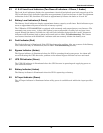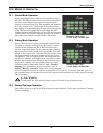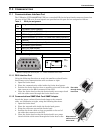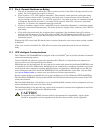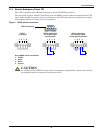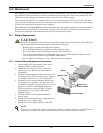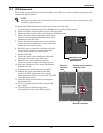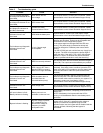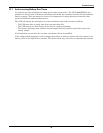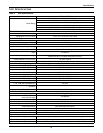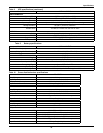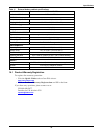
Troubleshooting
37
All audible alarms can be silenced, with the exception of Low Battery, Bypass Reminder and Missing
Batteries at Startup alarms. Once silenced, the alarm will not sound again until a new alarm condi-
tion is present.
Table 5 Alarm conditions
Condition Alarm
Battery Mode (utility failure) One short beep every 10 seconds; more than 2 minutes of run time remaining
Low Battery Two short beeps every 5 seconds; less than 2 minutes of run time remaining
On Bypass Reminder A one-second beep every 2 minutes
Output Overload (bypass) One short beep every half second
Overtemperature (bypass) A one-second, or two-second, beep every 4 seconds
DC Bus Overvoltage (bypass) A one-second, or two-second, beep every 4 seconds
Control Power Supply Failure (bypass) A one-second, or two-second, beep every 4 seconds
PFC Failure (bypass) A one-second, or two-second, beep every 4 seconds
Inverter Failure A one-second, or two-second, beep every 4 seconds
Inverter-to-Inverter Communications
Failure
A one-half second beep every 1 second
Battery Test Failure A two-second beep every 1 minute
REPO Activated A one-quarter second beep every half second
Table 6 Troubleshooting guide
Problem Cause Solution
UPS fails to start when the
ON button is pressed.
UPS is short-circuited or
overloaded.
Ensure the UPS is OFF. Disconnect all loads and ensure
nothing is lodged in output receptacles.
Ensure the loads are not defective or shorted internally.
Battery indicator is
illuminated.
UPS not plugged in.
UPS is operating in Battery Mode, make certain UPS is
securely plugged into the wall receptacle.
UPS input protection fuse
has blown/opened.
UPS is operating in Battery Mode. Save data and close
applications. Replace UPS input fuse, then restart UPS.
Utility voltage out of UPS
input range.
UPS is operating in Battery Mode. Save data and close
applications. Ensure utility supply voltage is within
acceptable limits for UPS.
UPS has reduced battery
time.
Batteries are not fully
charged.
Keep UPS plugged in continuously at least 24 hours to
recharge batteries.
UPS is overloaded. Check load level display and reduce the load on the UPS.
Batteries may not be able to
hold a full charge due to age.
Replace batteries. Contact your local dealer, Liebert
representative or the Liebert Worldwide Support Group for
replacement battery kit.
Fault and Bypass indicators
and all Load Level indicators
are illuminated.
UPS overloaded or load
equipment is faulty.
Check load level display and remove non-essential loads.
Recalculate the load and reduce number of loads
connected to UPS. Check load equipment for faults.
Fault and Bypass indicators
and diagnostic indicator C are
illuminated.
UPS control power supply
fault.
UPS requires service. Contact your local dealer, Liebert
representative or the Liebert Worldwide Support Group.
Fault and Bypass indicators
and diagnostic indicator D are
illuminated.
UPS PFC (Power Factor
Correction Circuit) fault.
UPS requires service. Contact your local dealer, Liebert
representative or the Liebert Worldwide Support Group.
Fault and Bypass indicators
and diagnostic indicator A are
illuminated.
UPS internal fan has a
problem or UPS shutdown
due to temperature
condition. Load is on bypass
power.
Ensure the UPS is not overloaded, ventilation openings
are not blocked and room ambient temperature is not
excessive.
Wait 30 minutes to allow UPS to cool, then restart UPS.
If UPS does not restart, contact your local dealer, Liebert
representative or the Liebert Worldwide Support Group.



